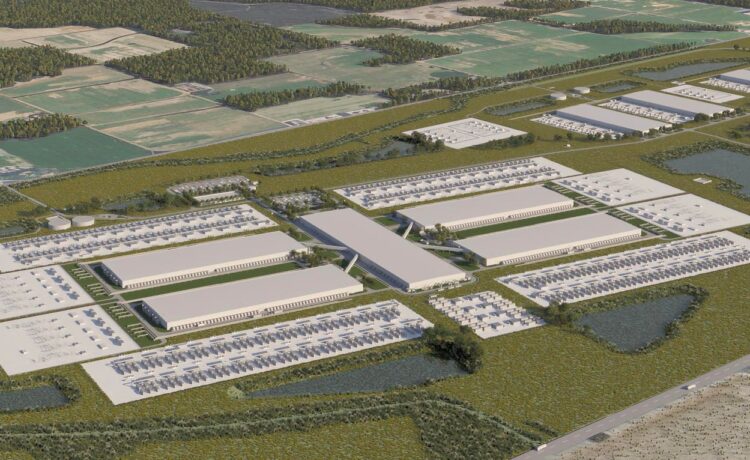This will be a defining year for AI,” said Mark Zuckerberg on his Facebook blog last month, hyping his plan to invest $65 billion in 2025, most of it in support of growing Meta’s AI capabilities and building upon its Llama 4 model.
The locus of these efforts appears to be on 2,250 acres of flat farmland in northeast Louisiana, where Meta has begun work on a $10 billion data center project. This grandest of Meta’s 20 worldwide data centers will be called Sucré (i.e. sweet) and cover 4 million square feet of floor space on 2,250 acres
To power racks lined with thousands of Nvidia H100 GPUs, Sucre will require 2.23 gigawatts of 24/7 electricity (enough to power more than 2 million homes), which utility company Entergy will provide via twin high-efficiency natural gas turbines at a capital cost of $3.2 billion. Meta’s plans also call for $250 million in related infrastructure spending, including roads and water systems. Construction jobs will peak at 5,000.
Is this really going to get built? And is it even a good idea, given recent revelations from DeepSeek that building advanced machine intelligence might be cheaper, and less energy-intensive than initially believed.
Billionaires’ Row: Zuckerberg, Bezos, Musk, and more at Trump’s inauguration.
POOL/AFP via Getty Images
For some perspective I talked with Zack Krause, an analyst at energy consultancy East Daley Analytics, in Dallas, who tracks data center announcements and works on handicapping both their likelihood of getting built, and how developers expect to provide for their electricity demand. Krause says he has been encouraging his institutional investor clients (many natural gas and power generation investors among them) not to panic over the implications.
“We’ve seen a short-term overreaction by the market to new tech,” says Krause, who includes on his list 290 datacenter projects with a decent likelihood of getting built.
Even if AI energy efficiency improves exponentially, the silicon brains of the future will need all of those server farms, and then some. That’s because of a dynamic called the Jevons Paradox, named after English economist William Jevons, who in 1865 noticed that efficiency breakthroughs in steam engine design did not reduce coal consumption at all, but instead caused demand for the fuel to surge. Jevons Paradox has also been observed, for example, in explosive demand for modern conveniences like air conditioning, passenger airplanes, and MRI machines.
Microsoft CEO Satya Nardella in late January tweeted about the Jevons paradox: “As AI gets more efficient and accessible, we will see its use skyrocket, turning it into a commodity we just can’t get enough of.” Analyst Hugh Wynne, at Power Research Group, concurs: “The demand for power to train and operate AI models could be materially reduced. However, if these efficiency gains also drive down the cost of AI, the adoption of AI-based services could be significantly faster and more widespread” — thus wiping out any expected energy savings.
Krause sees America’s tsunami of advanced data centers demanding an additional 81 gigawatts of electricity by 2030. That’s enough to power all of Texas today. If developers used natural gas to run them all it would take about 12.9 billion cubic feet per day, he figures — equal to 10% of national natural gas supplies. “The Meta project is circled in red ink for its eventual impact to the natural gas market,” he says, figuring that Sucre will require 360 million cubic feet of natural gas per day, the energy equivalent of about 60,000 barrels of oil.
And Sucré is not even the biggest. OpenAI is partnering with Oracle, Softbank, Microsoft and others on the Stargate project, which they say will be a $500 billion, multi-site datacenter expansion, beginning with Abilene, Texas. In time, Stargate will need more than 5 gigawatts of electricity, though Krause has only factored in a small fraction of that demand until they build something. Microsoft plans $80 billion of capital investment on AI and cloud computing this year. Meanwhile, Amazon has earmarked $100 billion for AI over the next decade, and may spend $35 billion just in northern Virginia’s datacenter alley. Jeff Bezos has also invested heavily in the development of advanced nuclear technology.
Amazon data centers in northern Virginia loom over McMansions.
Getty Images
A trend to watch: Energy giant Chevron has partnered with gas turbine specialist G.E. Vernova to develop the power systems for 4 gigawatts of datacenters. Chevron, Exxon and the like already have deep expertise in generating power at their giant oil refineries. By siting datacenters adjacent to existing natural gas fields, they can help AI developers sidestep time-consuming permitting hoops that regulated utility companies and pipeline operators must jump through. Says Krause: “The utilities are slower to react, while the pipelines and gas producers are drooling on the other side.”
Zuckerberg managed to sidestep NIMBY issues in Louisiana, where politicians handed Meta fat tax incentives to build. Gov. Jeff Landry oddly declared that the hyperscale server farm “revitalizes one of our state’s beautiful rural areas.” Northern Louisiana is also long on natural gas, thanks to fracking in the Haynesville shale.
Meta, which has committed to achieving carbon neutrality in its operations, is already working to assuage the guilt of relying on carbon dioxide emitting natural gas to run Sucré. In December Meta announced a deal with billionaire Michael Polsky’s power developer Invenergy to buy the green attributes (known as renewable energy certificates) from the 760 megawatt capacity of four big solar farms under construction. And in Louisiana Meta has pledged to invest $1.5 billion alongside Entergy to build out more wind and solar.
Give it another 10 years and Meta will hopefully be able to retrofit the datacenter to run on zero-emissions advanced nuclear. Zuckerberg already looked in to building a datacenter adjacent to a nuclear power plant (rumored to be California’s Diablo Canyon site) but was stymied by the discovery of an endangered bee species nearby.
It’s why Krause excludes from his datacenter list dozens of projects more aspirational than real. “The upper bound is inflated. Some developers take a shotgun approach to permitting — they’re trying to get land rezoned by the multitudes.”

















